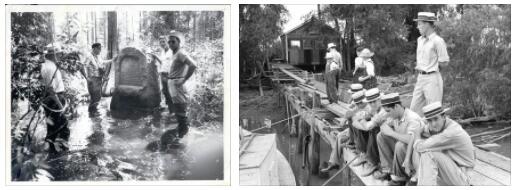Population: 4 574.836 thousand people (2010)
Area: 135382.0 sq. km
Louisiana is located in the south of the United States, which is the 18th in a row that entered the Union. Its capital is the city of Baton Rouge. Until the devastating invasion of Hurricane Katrina, New Orleans was the largest city. The Pelican State is Louisiana’s nickname. The origin of the name of the state is associated with the name of the French king Louis IV. Previously, Louisiana was called the lands lying to the coast of the Gulf of Mexico, which were under the control of the French.
The western territories of present-day Louisiana border on Texas, in the eastern part – on Mississippi, in the north – on Arkansas, the southern part is washed by the waters of the Gulf of Mexico. The area of the whole state is divided into upper and lower parts, the latter of which is replete with swampy low-lying areas. The highest point is Driskill Hill, which is 163 meters above sea level.
The main part of the population in the south of the state are Creoles, as well as Cajuns, who are of French origin. Each group has retained its culture, way of life and language. But over time, there has been a mixing of cultures and traditions. Cajuns are descendants of the French, who were evicted at one time from the territory of present-day Nova Scotia. Creoles of the state are divided into white and black. The former are of Spanish and French origin. The latter are a mixture of African, Spanish and Native American origins.
The lands of the current state were discovered and explored by the Spaniards, starting with the expedition of Hernando de Soto in 1539-1542. In those days, the Indians of the Atakapa, Chitimacha, Choctaw, Tunica-Biloxi and others lived here. In 1682, Cavalier de la Salle came to the local shores, who declared the territory of the Mississippi River basin the property of France. Subsequently, the king of France appointed him governor of the newly formed colony.
In 1718 a city was formed with the name New Orleans. After the expiration of time in 1763, the eastern part of the French colony became controlled by the British, the western part passed to the Spaniards, but by 1800 it again became French property. After the founding of the United States, the eastern lands of Louisiana became part of the new country. In December 1803, the United States purchased western Louisiana from the French. In 1849, Baton Rouge became the new state capital.
BATON ROUGE
Population: 229.553 thousand people (2010)
Area: 204.8 sq. km
Time zone: UTC-6, summer UTC-5
Altitude: 14 m
Zip code: 70801
The capital of Louisiana, Baton Rouge, is located in the southeast of the state. The city is located on the banks of the Mississippi in East Baton Rouge County. The city is a major river port, where Panamax-class ships (the maximum dimensions for ships passing through the Panama Canal) can call. It is also the center of the oil refining industry.
The name Baton Rouge means “red stick” in French. French sailors once noticed a cypress tree here, hung with bloodied animal skins and heads (this is how the local tribes marked the boundaries of their possessions), and called this place a “red (bloody) stick”.
Until the 17th century, these wet swampy lands were inhabited by tribes of hunter Indians who wildly resisted European attempts to colonize the region. The French, the British, the Spaniards, and later the citizens of the United States until the 19th century could not establish a normal economy here. After colonization, cotton plantations were spread here and there was an active river trade, including slaves. The first settlement on the site of Baton Rouge appeared in 1699 through the efforts of Captain D’Iberville. For some time, the British owned the town, and in 1803 it became part of the United States along with all of Louisiana. In 1849, the state capital was moved to Baton Rouge from New Orleans.
In Baton Rouge, half of the population of which are African Americans, the tourism industry is well developed. The main attraction is considered to be the building strictly the Louisiana Capitol. Part of the neo-Romanesque buildings remained from the French period. The city has many recreational areas, including a zoo. Baton Rouge hosts many guests during the Balloon Festival.
LAFAYETTE
Population: 110.275 thousand people (2000)
Area: 123.5 sq. km
Founded: 1821
Time zone: UTC-6, summer UTC-5
Altitude: 11 m
Zip code: 70501, 70503, 70506-08
Lafayette – This European-American city is located along the Vermillion River in the southeastern United States and is the seat of Lafayette County in the state of Louisiana. The Vermillion River flows through downtown Lafayette. There are other important water arteries in the city: Isaac Vero-Couley, Coulee Main, Coulee des Poches and Coulee Ile de Cannes.
This unique city was founded by Jean Mouton in 1821 and was originally called Vermilionville. In 1884, the city was renamed in honor of General Lafayette, a famous independence fighter who made a great contribution to the victory of the American army during the American war.
The city’s economy was originally based on agriculture, until the oil and gas industry was developed. The city is one of the centers of education, in particular, it is home to the second largest university in the state, one community college and two vocational colleges.
This unique city is home to the renowned arts center Acadian Village. The city’s hallmark is also the well-known Jean Lafitte National Historical Park and Reserve. This picturesque and extraordinary park was named after Jean Lafitte – a French-American pirate, a famous fighter for the freedom and independence of New Orleansfrom the English occupation at the beginning of 1815. It was thanks to this brave pirate and his team that they managed to survive and win this unequal and tough confrontation. Given the peculiarities of the origin of Jean Lafitte in the park, in memory of his exploits is the famous French Quarter in the city – the oldest district of the city, also known as Vieux Carré. The area is known as a National Historic Landmark, with numerous architecturally unique buildings.
Also in the city you can visit children’s museums, luxurious parks, zoos. Lafayette is famous for its outstanding nature reserves, where you can plunge into the era of yesteryear and walk along exclusive trails, canoe through the picturesque floodplains of deciduous forests. In the reserves, you can order a special tour of mysterious and unique natural places.
Lafayette, Louisiana
Lafayette, Louisiana, is a city with a rich cultural heritage deeply rooted in the traditions of Acadiana and Cajun culture. Known for its vibrant music, unique cuisine, and lively festivals, Lafayette has a history shaped by the convergence of diverse cultures and a climate that reflects the warmth and humidity of the southern United States.
The history of Lafayette can be traced back to the 18th century when French settlers, known as Acadians, were forced to leave Canada and resettled in the area after the British expelled them from Acadia (now Nova Scotia). These Acadians, along with other French, Spanish, and Creole settlers, established a thriving agricultural community in the region, cultivating rice, sugarcane, and other crops.
The city was officially founded in 1821 as Vermilionville, named after the nearby Vermilion River. In 1884, the name was changed to Lafayette in honor of the Marquis de Lafayette, a French general who played a crucial role in the American Revolutionary War. Lafayette became the seat of government for Lafayette Parish, and its cultural tapestry continued to evolve with the intermingling of Acadian, French, Spanish, African, and Creole influences.
According to Computerdo, Lafayette’s climate is classified as humid subtropical, characterized by hot and humid summers and mild winters. Average high temperatures in the summer months range from the low 90s to mid-90s Fahrenheit (32-35°C), while winter highs typically range from the mid-50s to mid-60s Fahrenheit (12-18°C). The region experiences high humidity levels throughout the year.
The warm climate has a significant impact on the local flora and fauna, contributing to the lush landscapes and vibrant vegetation that define the area. The extensive bayous and swamps surrounding Lafayette are teeming with wildlife and serve as important ecosystems in the region.
One of the defining features of Lafayette’s cultural history is its connection to Cajun and Zydeco music. The city has played a central role in the preservation and promotion of these musical genres, with venues like the Blue Moon Saloon and festivals like Festival International de Louisiane showcasing the rich musical traditions of the region. Lafayette’s downtown area, with its historic architecture and lively atmosphere, serves as a hub for cultural activities and live music.
Cajun cuisine, renowned for its bold flavors and unique combinations, is another integral part of Lafayette’s identity. Dishes like gumbo, jambalaya, boudin, and crawfish étouffée are staples of the local culinary scene. Lafayette hosts various food festivals throughout the year, celebrating the city’s gastronomic heritage and attracting food enthusiasts from across the country.
The city’s commitment to cultural preservation is evident in places like Vermilionville, a living history museum that recreates life in Acadiana during the 18th and 19th centuries. The Acadian Cultural Center, part of the Jean Lafitte National Historical Park and Preserve, also provides insights into the cultural diversity and history of the region.
Lafayette has faced challenges, including those associated with economic shifts in the oil and gas industry, which has historically played a significant role in the local economy. However, the city has diversified its economic base, with healthcare, education, and technology sectors contributing to its growth and stability.
The University of Louisiana at Lafayette, a prominent educational institution, has played a vital role in shaping the academic and cultural landscape of the city. The university hosts cultural events, including the Festival of the Arts, contributing to the city’s reputation as a center for arts and education.
Lafayette, Louisiana, stands as a cultural gem in the southern United States, with a history shaped by the convergence of diverse cultural influences. From its origins as a settlement for Acadian refugees to its vibrant present as a hub for music, cuisine, and festivals, Lafayette embraces its cultural heritage with pride. The city’s warm and humid climate further enhances the allure of this unique destination, offering a welcoming atmosphere for residents and visitors alike.









